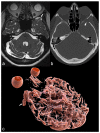Morphological and Advanced Imaging of Epilepsy: Beyond the Basics
- PMID: 30862078
- PMCID: PMC6462967
- DOI: 10.3390/children6030043
Morphological and Advanced Imaging of Epilepsy: Beyond the Basics
Abstract
The etiology of epilepsy is variable and sometimes multifactorial. Clinical course and response to treatment largely depend on the precise etiology of the seizures. Along with the electroencephalogram (EEG), neuroimaging techniques, in particular, magnetic resonance imaging (MRI), are the most important tools for determining the possible etiology of epilepsy. Over the last few years, there have been many developments in data acquisition and analysis for both morphological and functional neuroimaging of people suffering from this condition. These innovations have increased the detection of underlying structural pathologies, which have till recently been classified as "cryptogenic" epilepsy. Cryptogenic epilepsy is often refractory to anti-epileptic drug treatment. In drug-resistant patients with structural or consistent functional lesions related to the epilepsy syndrome, surgery is the only treatment that can offer a seizure-free outcome. The pre-operative detection of the underlying structural condition increases the odds of successful surgical treatment of pharmacoresistant epilepsy. This article provides a comprehensive overview of neuroimaging techniques in epilepsy, highlighting recent advances and innovations and summarizes frequent etiologies of epilepsy in order to improve the diagnosis and management of patients suffering from seizures, especially young patients and children.
Keywords: cortical malformations; diffusion tensor imaging; epilepsy; hippocampal sclerosis; magnetic resonance imaging (MRI); positron emission topography-computed tomography (PET-CT); single positron emission computed tomography (SPECT); spectroscopy.
Conflict of interest statement
The authors declare no conflict of interest.
Figures














Similar articles
-
Neuroimaging of epilepsy.Handb Clin Neurol. 2016;136:985-1014. doi: 10.1016/B978-0-444-53486-6.00051-X. Handb Clin Neurol. 2016. PMID: 27430454 Free PMC article. Review.
-
Imaging for Adults With Seizures and Epilepsy.Continuum (Minneap Minn). 2016 Oct;22(5, Neuroimaging):1451-1479. doi: 10.1212/CON.0000000000000370. Continuum (Minneap Minn). 2016. PMID: 27740984 Review.
-
Utility of MRI, PET, and ictal SPECT in presurgical evaluation of non-lesional pediatric epilepsy.Seizure. 2020 Apr;77:15-28. doi: 10.1016/j.seizure.2019.05.008. Epub 2019 May 11. Seizure. 2020. PMID: 31122814 Free PMC article. Review.
-
Imaging and epilepsy.Brain. 1997 Feb;120 ( Pt 2):339-77. doi: 10.1093/brain/120.2.339. Brain. 1997. PMID: 9117380 Review.
-
[Investigation of epilepsy. Magnetic tomography more and more important as a diagnostic technique].Lakartidningen. 1997 Jun 4;94(23):2194-200. Lakartidningen. 1997. PMID: 9213686 Review. Swedish.
Cited by
-
Use of Innovative SPECT Techniques in the Presurgical Evaluation of Patients with Nonlesional Extratemporal Drug-Resistant Epilepsy.Mol Imaging. 2021 Mar 2;2021:6614356. doi: 10.1155/2021/6614356. eCollection 2021. Mol Imaging. 2021. PMID: 33746629 Free PMC article. Review.
-
A journey through formation and malformations of the neo-cortex.Childs Nerv Syst. 2020 Jan;36(1):27-38. doi: 10.1007/s00381-019-04429-0. Epub 2019 Nov 27. Childs Nerv Syst. 2020. PMID: 31776716 Review.
-
Factors influencing the detection of treatable epileptogenic lesions on MRI. A randomized prospective study.Neurol Res Pract. 2021 Aug 9;3(1):41. doi: 10.1186/s42466-021-00142-z. Neurol Res Pract. 2021. PMID: 34365971 Free PMC article.
-
Differentiation of Epileptic Brain Abnormalities among Neurological Patients at Taif Region Using MRI.Int J Clin Pract. 2023 Nov 11;2023:8783446. doi: 10.1155/2023/8783446. eCollection 2023. Int J Clin Pract. 2023. PMID: 38020535 Free PMC article.
-
Narrative review of epilepsy: getting the most out of your neuroimaging.Transl Pediatr. 2021 Apr;10(4):1078-1099. doi: 10.21037/tp-20-261. Transl Pediatr. 2021. PMID: 34012857 Free PMC article. Review.
References
-
- Online Etymology Dictionary. [(accessed on 18 December 2018)]; Available online: https://www.etymonline.com/word/epilepsy.
-
- National Public Radio. [(accessed on 18 December 2018)]; Available online: https://www.npr.org/2011/09/30/140954025/science-diction-the-origin-of-t....
-
- Jin B., Krishnan B., Adler S., Wagstyl K., Hu W., Jones S., Najm I., Alexopoulos A., Zhang K., Zhang J., et al. Automated detection of focal cortical dysplasia type II with surface-based magnetic resonance imaging postprocessing and machine learning. Epilepsia. 2018;59:982–992. doi: 10.1111/epi.14064. - DOI - PMC - PubMed
Publication types
LinkOut - more resources
Full Text Sources

